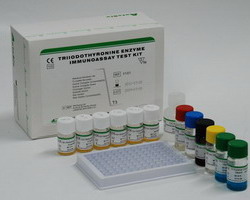Products
| In Vitro Diagnostic |
| Instruments |
| Reagents |
| Consumables |
| Laboratory Science |
| Thyroid |
Available kits: T3, T4, TSH, f-T3, f-T4, TG-Ab, TM-Ab, TPO-Ab
Introduction
The hormones thyroxine (T4) and 3, 5, 3 thiiodothyronine (T3) circulate in the bloodstream, mostly bound to the plasma protein, thyroxine binding globulin (TBG). The concentration of T3 is much less than that of T4, but its metabolic potency is much greater. T3 determination is an important factor in the diagnosis of thyroid diseases.Its measurement has uncovered a variant of hyperthyroidism in thyrotoxic patients with elevated T3 levels and normal T4 levels. An increase in T3 without an increase in T4 is frequently a forerunner of recurrent thyrotoxicosis in previously treated patients. The clinical significance of T3 is also evident in patients in whom euthyroidism is attributable only to normal T3, although their T4 values are subnormal.T3 determination is also useful in monitoring both patients under treatment for hyperthroidism and patients who have discontinued anti-thyroid drug therapy. It is especially valuable in distinguishing between euthyroid and hyperthyroid subjects.
In addition to hyperthyroidism, T3 levels are elevated in women who are pregnant, and in women receiving oral contraceptives or estrogen treatment, paralleling TBG increases in a manner analogous to T4 levels.Likewise, a reduction in TBG concentration decreases T3 concentration. These changes in the T3 level, however, are not a true reflection of thyroid status.
T4 ELISA Thyroxine or 3, 5, 3', 5'-tetraiodo-L-thyronine (T4) is the major hormone produced by the thyroid gland. It has a molecular weight of 777 daltons and is synthesized by iodination of tyrosine residues on thyroglobulin. Proteolytic cleavage of follicular thyroglobulin releases T4 into the bloodstream. Greater than 99% of T4 is reversibly bound to three plasma proteins in blood - thyroxine binding globulin (TBG) binds 70%, thyroxine binding pre-albumin (TBPA) binds 20%, and albumin binds 10%. Approximately 0.03% of T4 is in the free, unbound state in blood at any time.
Diseases effecting thyroid function may present a wide array of confusing symptoms. Measurement of total T4 by immunoassay is the most reliable and convenient screening test available to determine the presence of thyroid disorders in patients. Increased levels of T4 have been found in hyper-thyroidism due to Grave's disease and Plummer's disease and in acute and subacute thyroiditis. Low levels of T4 have been associated with congenital hypothyroidism, myxedema, chronic thryoiditis (Hashimoto’s disease), and with some genetic abnormalities.
TSH ELISA
Although the concentration of TSH in the blood is extremely low, it is essential for the maintenance of normal thyroid function. The release of TSH is regulated by a TSH-releasing hormone (TRH) produced by the hypothalamus. The levels of TSH and TRH are inversely related to the level of thyroid hormone. When there is a high level of thyroid hormone in the blood, less TRH is released by the hypothalamus, so less TSH is secreted by the pituitary. The opposite action will occur when there is decreased thyroid hormone in the blood. This process is known as a negative feedback mechanism and responsible for maintaining the proper blood levels of these hormones. TSH and the pituitary glycoproteins, luteinizing hormone (LH), follicle-stimulating hormone (FSH), and human chorionic gonadotropin(HCG), have identical alpha chains. The beta chains are distinct but do contain regions with identical amino acid sequences. These regions of homology can cause considerable cross-reactivity with some polyclonal TSH antibodies. The use of a monoclonal antibody in this TSH ELISA test eliminates this interference, which could result in falsely elevated TSH values in either menopausal or pregnant females, a population whose evaluation of thyroid status is clinically significant.
f-T3 ELISA
Triiodothyronine (T3), a thyroid hormone, circulates in blood almost completely bound (>99.5%) to carrier proteins. The main transnport protein is thyroxine-binding globulin (TBG). However, only the free (unbound) portion of triiodothyronine is believed to be responsible for the biological action. Further, the concentrations of the carrier proteins are altered in many clinical conditions, such as pregnancy. In normal thyroid function as the concentrations of the carrier proteins alter, the total triiodothyronine level changes so that the free triiodothyronine concentrations remains constant. Thus, measurements of free triiodothyronine concentrations correlate more reliably with clinical status than total triiodthyronine levels. For example, the increase in total triiodothyronine levels associated with pregnancy, oral contraceptives and estrogen therapy result in higher total T3 levels while the free T3 concentration remains basically unchanged.This ELISA test provides the technician with optimum sensitivity while requiring few technical manipulations in a direct determination of free T3.
f-T4 ELISA
Thyroxine, the principal thyroid hormone, circulates in blood almost completely bound to carrier proteins. The main carrier is thyroxine-binding globulin (TBG). However, only the free (unbound) portion of thyroxine is responsible for the biological action. Further, the concentrations of the carrier proteins are altered in many clinical conditions, such as pregnancy. Under normal thyroid condition, as the concentrations of the carrier proteins alter, the total thyroxine level changes so that the free thyroxine concentration remains constant. Thus, measurement of free thyroxine concentrations correlate better with clinical status than total thyroxine levels.
For example, the increase in total thyroxine associated with pregnancy, oral contraceptives and estrogen therapy occasionally result in total T4 levels over the limits of normal while the free thyroxine concentation remains within the normal reference range. Masking of abnormal thyroid function can also occur in both hyper and hypothyroid conditions by alterations in the TBG concentration. The total T4 can be elevated or lowered by TBG changes such that the normal reference levels result is observed. Again, the free thyroxine concentration typically uncovers the patient’s actual clinical status. |


